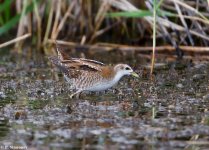-
Welcome to BirdForum, the internet's largest birding community with thousands of members from all over the world. The forums are dedicated to wild birds, birding, binoculars and equipment and all that goes with it.
Please register for an account to take part in the discussions in the forum, post your pictures in the gallery and more.
You are using an out of date browser. It may not display this or other websites correctly.
You should upgrade or use an alternative browser.
You should upgrade or use an alternative browser.
Crake Romania (1 Viewer)
- Thread starter Pavel
- Start date
More options
Who Replied?Pavel
Well-known member
I have no books to hand but haven't you got two crakes there - baillons and little, maybe. Like I say no books to hand, no real experience of crakes. As I remember the bill is the key with juvs... Sorry haven't helped much...
Thanks for your comment (merci beaucoup) - no real experience either (seen once in Corsica)!
It was a guided tour with experienced birdwatchers from France, including my friend Philippe Huet who had seen several times both species together. We also think there are two juvenile crakes - one Little and one Baillon's (right), obviously smaller presenting short primary projection, short tail (never cocked up or raised vertically), never pending its wings like Little Crake, broad-billed looking, no red or pink on bill-base at all, having very narrow, buff-grey indistinct (not broad and white) supercilium. It looked like a dirty chick, not nice! The shape and habits (reminding NZ Kiwi
Attachments
Last edited:
phil baber
Clipped Wing

Juv Baillon's in front. And a (juv) Little behind. Maybe the best photo ever taken?! 

Thanks for your comment (merci beaucoup) - no real experience either (seen once in Corsica)!
It was a guided tour with experienced birdwatchers from France, including my friend Philippe Huet who had seen several times both species together. We also think there are two juvenile crakes - one Little and one Baillon's (right), obviously smaller presenting short primary projection, short tail (never cocked up or raised vertically), never pending its wings like Little Crake, broad-billed looking, no red or pink on bill-base at all, having very narrow, buff-grey indistinct (not broad and white) supercilium. It looked like a dirty chick, not nice! The shape and habits (reminding NZ Kiwi) quite different from Little Crake, which is looking nice, longer, slender and long-necked. See more photos of both birds.
I still see a rather long PP with at least 5 primary tips visible and no tail cocking as tail is missing
I still see a rather long PP with at least 5 primary tips visible and no tail cocking as tail is missing
But no red base to the bill?
kuzeycem
Medicinal Birding

The throat and breast are too pale and unmarked for Baillon's, and the (apparent) lack of red shouldn't be a big problem for a juvenile.
http://www.sakertour.com/hide_gallery_classic.php?hide=5&author=&text=&page=3 The left bird here is quite similar.
http://www.sakertour.com/hide_gallery_classic.php?hide=5&author=&text=&page=3 The left bird here is quite similar.
Earnest lad
Well-known member
Although I'm not an expert I am going to put my guestimate of:
2x Little Crake
The following link is an article about separating juvenile Little and Baillons Crake in the field
https://www.britishbirds.co.uk/wp-c...e_files/V86/V86_N07/V86_N07_P303_311_A089.pdf
2x Little Crake
The following link is an article about separating juvenile Little and Baillons Crake in the field
https://www.britishbirds.co.uk/wp-c...e_files/V86/V86_N07/V86_N07_P303_311_A089.pdf
Last edited:
Pavel
Well-known member
Pavel
Well-known member
Although I'm not an expert I am going to put my guestimate of:
2x Little Crake
The following link is an article about separating juvenile Little and Baillons Crake in the field
https://www.britishbirds.co.uk/wp-c...e_files/V86/V86_N07/V86_N07_P303_311_A089.pdf
Thanks for your non expert guestimation!
Pavel
Well-known member
Juv Baillon's in front. And a (juv) Little behind. Maybe the best photo ever taken?!
Thank you Phil.
Earnest lad
Well-known member
I understand that although the Little Crake is not rare in Romania around the delta and black sea area, the Baillons, to my knowledge (admittedly limited knowledge although I was in Romania recently) not (to me at least) known to be present (although I stand to be corrected if other(s) who know more than me (about Romanian birding) are around on the forum.
Also I am drawing attention to the close proximity of the two birds in the photo with the suggestion this could imply a likely or at least possible familial relationship or at the very least conspecificity. Perhaps it was a father and son photo. How cute
Also I am drawing attention to the close proximity of the two birds in the photo with the suggestion this could imply a likely or at least possible familial relationship or at the very least conspecificity. Perhaps it was a father and son photo. How cute
PYRTLE
Old Berkshire Boy

I think we can safely assume that both are juvenile birds in the photos. Photo 1. shows a juv. Little Crake as the back left hand bird and again in Photo 2. It's the other bird causing confusion. Photo 3. suggests Baillon's to me as does the right hand bird in the original post.
There are various pro Baillon's features already pointed out and I think Photo 3. shows more than 3 primaries, due to it stooping and thus exposing other p.feathers.
What is puzzling to me is that both species being juvs. at the same location. How likely is that?
Particularly if Baillons is rare or a non breeder in Romania.
Perhaps this is where a ringing scheme could be considered for post breeding next year to establish which species of crake are present at this site.
Pavel, Perhaps you have contacts in Romania?
There are various pro Baillon's features already pointed out and I think Photo 3. shows more than 3 primaries, due to it stooping and thus exposing other p.feathers.
What is puzzling to me is that both species being juvs. at the same location. How likely is that?
Particularly if Baillons is rare or a non breeder in Romania.
Perhaps this is where a ringing scheme could be considered for post breeding next year to establish which species of crake are present at this site.
Pavel, Perhaps you have contacts in Romania?
Richard Prior
Halfway up an Alp

Baillon's remains the least known of the WP crakes in terms of breeding density but there's no reason why it shouldn't be present in Romania, as a scarce breeder (as Cramp and co. in BWP suggested) and passage migrant.
For me the photo shows a Baillon's in the foreground and a Little Crake behind it, the Baillon's looks typically 'dumpy', and to my eyes the throat and chest are not too pale, and they are marked giving that 'dirty' appearance.
For me the photo shows a Baillon's in the foreground and a Little Crake behind it, the Baillon's looks typically 'dumpy', and to my eyes the throat and chest are not too pale, and they are marked giving that 'dirty' appearance.
Pavel
Well-known member
Thank you PYRTLE & Richard for your comments. Just to add that we've seen many adult and juveniles Little Crakes but the bird in question was different in shape, size and behavior, believe me. That could only be a Baillon's Crake or a new species for the science. 
However, I would be very pleased to receive the opinion of Thibaut Tib78 as well.
However, I would be very pleased to receive the opinion of Thibaut Tib78 as well.
lou salomon
the birdonist
as per information about baillon's crake in romania: in recent years it was found breeding at exactly the same site and also in 3 other places in southeastern romania. it still is rare but of course probably breeding in more places not yet known. we are at least glad that breedingh finally has been confirmed now in 3-4 locations.
Similar threads
- Replies
- 1
- Views
- 393
Users who are viewing this thread
Total: 2 (members: 0, guests: 2)








